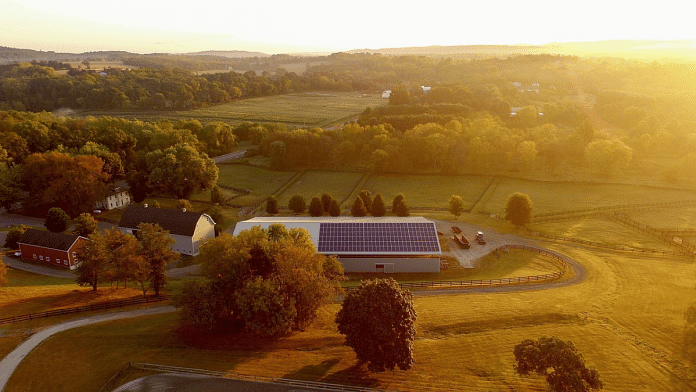As temperatures soar to record levels and wildfires rage around the world, the need to meet net zero targets has never been more urgent. At the same time, increasing climate resilience across food systems will be needed to counter rising hunger and malnutrition, according to UN General Assembly President Abdulla Shahid.
Agrivoltaic farming could be a solution to not just one but both of these problems. It uses the shaded space underneath solar panels to grow crops.
This increases land-use efficiency, as it lets solar farms and agriculture share ground, rather than making them compete against one another.
And certain crops appear to thrive when grown in such environments, according to a number of recent studies.
Solar panels have to sometimes be elevated or suspended to allow plants to grow beneath them. Another option is putting them on the roofs of greenhouses. This allows enough light and rainwater to reach the crops, as well as providing access for farm machinery.
Where is agrivoltaic farming already in use?
Researchers in South Korea have been growing broccoli underneath photovoltaic panels.
The panels are positioned 2-3 metres off the ground and sit at an angle of 30 degrees, providing shade and offering crops protection from the weather.
A study into this project found that the quality of the broccoli was not any lower than that of broccoli grown in the traditional way. Nor was there any significant change in its taste.
The researchers, from Chonnam National University, also discovered that the broccoli produced was a deeper shade of green, making it more appealing to many consumers.
Elsewhere, agrivoltaic systems in East Africa are allowing farmers to make better use of land that was previously seen as unviable.
An Agrivoltaic farming project in Kenya is using solar panels held several metres off the ground, with gaps in between them. The shade from the panels protects vegetables from heat stress and water loss.
This has resulted in rural farmers being able to grow a greater range of higher-value crops. The project effectively harvests the power of the sun twice, the researchers say.
If solar panels can be added to greenhouses, the results could be especially transformative. Greenhouse-based farming reportedly produces 10 times more food than growing in an open field, but it can require 10 times as much power.
How could this help tackle climate change?
Increasing the world’s solar energy capacity will be a big part of solving the sustainability equation.
At the same time, the UN estimates that the global population is set to rise by an estimated 2 billion people in the next 30 years, and land is at a premium.
Agrivoltaics is one way of using the same area of land to produce more food while also rolling out more sources of renewable energy.
South Korea’s renewable energy use is the lowest among International Energy Agency member countries. Its land is also in short supply, due to mountainous terrain spanning 70% of the country, so agrivoltaic farming could be a game-changing solution.
As Brite Solar CEO Dr Nick Kanopoulos puts it: “All of this has profound environmental implications and points to a new way of farming – one that is fully electric, runs on renewable resources, and is capable of sustainably producing the food we need to feed the future.”
Stephen Hall is a Writer, Formative Content
This article was first published here.
Also read: Dropped my son to school in an Audi RS7. Came back with a lesson on sustainable development






